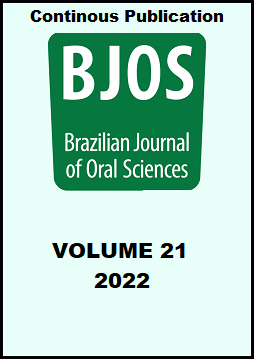Abstract
Aim: to evaluate the surgical effects of two rehabilitation protocols on dental arch occlusion of 5-year-old children with or without cleft lip and palate. Methods: this is a retrospective longitudinal study the sample comprised 45 digitized dental casts divided into followed groups: Group 1 (G1) – children who underwent to cheiloplasty (Millard technique) at 3 months and to one-stage palatoplasty (von Langenbeck technique) at 12 months; Group 2 (G2) – children who underwent to cheiloplasty (Millard technique) and two-stage palatoplasty (Hans Pichler technique for hard palate closure) at 3 months and at 12 months to soft palate closure (Sommerlad technique); and Group 3 (G3) – children without craniofacial anomalies. Linear measurements, area, and occlusion were evaluated by stereophotogrammetry software. Shapiro-Wilk test was used to verify normality. ANOVA followed by posthoc Tukey test and Kruskal-Wallis followed by posthoc Dunn tests were used to compared groups. Results: For the measures intercanine distance (C-C’), anterior length of dental arch (I-CC’), and total length of the dental arch (I–MM’), there were statistical differences between G1x G3 and G2xG3, the mean was smaller for G1 and G2. No statistically significant differences occurred in the intermolar distance and in the dental arch area among groups. The occlusion analysis revealed significant difference in the comparison of the three groups (p=0.0004). Conclusion: The surgical effects of two rehabilitation protocols affected the occlusion and the development of the anterior region of the maxilla of children with oral clefts when compared to children without oral clefts.
References
Shi B, Losee JE. The impact of cleft lip and palate repair on maxillofacial growth. Int J Oral Sci. 2015 Mar;7(1):14-7. doi: 10.1038/ijos.2014.59.
Pereira RMR, Siqueira N, Costa E, Vale D do, Alonso N. Unilateral cleft lip and palate surgical protocols and facial growth outcomes. J Craniofac Surg. 2018 Sep;29(6):1562-8. doi: 10.1097/SCS.0000000000004810.
Arosarena OA. Cleft lip and palate. Otolaryngol Clin North Am. 2007 Feb;40(1):27-60, vi. doi: 10.1016/j.otc.2006.10.011.
Sakoda KL, Jorge PK, Carrara CFC, Machado MAAM, Valarelli FP, Pinzan A, et al. 3D analysis of effects of primary surgeries in cleft lip/palate children during the first two years of life. Braz Oral Res. 2017 Jun;31:e46. doi: 10.1590/1807-3107BOR-2017.vol31.0046.
Demke JC, Tatum SA. Analysis and evolution of rotation principles in unilateral cleft lip repair. J Plast Reconstr Aesthet Surg. 2011 Mar;64(3):313-8. doi: 10.1016/j.bjps.2010.03.004.
Von Langenbeck B. Operation der anageborene totalen Spaltung des harten Gauments nach einer Methode. Dtsch Arch Klin Med. 1861;13:231.
Silva Filho OG, Freitas JAS. Caracterização morfológica e origem embriológica. Fissuras labiopalatais: uma abordagem interdisciplinar. São Paulo: Santos; 2007.
Bosi V, Brandão G, Yamashita R. Speech resonance and surgical complications after primary palatoplasty with intravelar veloplasty in patients with cleft lip and palate. Rev Bras Cir Plast. 2016;31(1):43-52. doi: 10.5935/2177-1235.2016RBCP0007.
Sommerlad BC, Mehendale FV, Birch MJ, Sell D, Hattee C, Harland K. Palate re-repair revisited. Cleft Palate Craniofac J. 2002 May;39(3):295-307. doi: 10.1597/1545-1569_2002_039_0295_prrr_2.0.co_2.
Maulina I, Priede D, Linkeviciene L, Akota I. The influence of early orthodontic treatment on the growth of craniofacial complex in deciduous occlusion of unilateral cleft lip and palate patients. Stomatologija. 2007;9(3):91-6.
Carrara CFC, Ambrosio ECP, Mello BZF, Jorge PK, Soares S, Machado MA, et al. Three-dimensional evaluation of surgical techniques in neonates with orofacial cleft. Ann Maxillofac Surg. 2016 Jul- Dec;6(2):246-50. doi: 10.4103/2231-0746.200350.
Ambrosio ECP, Sforza C, De Menezes M, Gibelli D, Codari M, Carrara CFC, et al. Longitudinal morphometric analysis of dental arch of children with cleft lip and palate: 3D stereophotogrammetry study. Oral Surg Oral Med Oral Pathol Oral Radiol. 2018 Dec;126(6):463-8. doi: 10.1016/j.oooo.2018.08.012..
Ambrosio ECP, Sforza C, De Menezes M, Carrara CFC, Machado MAAM, Oliveira TM. Post-surgical effects on the maxillary segments of children with oral clefts: New threedimensional anthropometric analysis. J Craniomaxillofac Surg. 2018 Sep;46(9):1511-4. doi: 10.1016/j.jcms.2018.06.017.
Rando GM, Jorge PK, Vitor LLR, Carrara CFC, Soares S, Silva TC, et al. Oral health-related quality of life of children with oral clefts and their families. J Appl Oral Sci. 2018 Feb;26:e20170106. doi: 10.1590/1678-7757-2017-0106.
Atack N, Hathorn I, Mars M, Sandy J. Study models of 5 year old children as predictors of surgical outcome in unilateral cleft lip and palate. Eur J Orthod. 1997 Apr;19(2):165-70. doi: 10.1093/ejo/19.2.165.
Bruggink R, Baan F, Kramer G, Maal TJJ, Kuijpers-Jagtman AM, Bergé SJ, et al. Three dimensional maxillary growth modeling in newborns. Clin Oral Investig. 2019 Oct;23(10):3705-12. doi: 10.1007/s00784-018-2791-5.
Zen I, Soares M, Pinto LMCP, Ferelle A, Pessan JP, Dezan-Garbelini CC. Maxillary arch dimensions in the first 6 months of life and their relationship with pacifier use. Eur Arch Paediatr Dent. 2020 Jun;21(3):313-9. doi: 10.1007/s40368-019-00487-9.
Reiser E, Skoog V, Andlin-Sobocki A. Early dimensional changes in maxillary cleft size and arch dimensions of children with cleft lip and palate and cleft palate. Cleft Palate Craniofac J. 2013 Jul;50(4):481-90. doi: 10.1597/11-003.
Huang C-S, Wang W-I, Liou EJ-W, Chen Y-R, Chen PK-T, Noordhoff MS. Effects of cheiloplasty on maxillary dental arch development in infants with unilateral complete cleft lip and palate. Cleft Palate Craniofac J. 2002 Sep;39(5):513-6. doi: 10.1597/1545-1569_2002_039_0513_eocomd_2.0.co_2.
Kongprasert T, Winaikosol K, Pisek A, Manosudprasit A, Manosudprasit A, Wangsrimongkol B, et al. Evaluation of the effects of cheiloplasty on maxillary arch in UCLP infants using three-dimensional digital models. Cleft Palate Craniofac J. 2019 Sep;56(8):1013-9. doi: 10.1177/1055665619835090.
Othman SA, Saffai L, Wan Hassan WN. Validity and reproducibility of the 3D VECTRA photogrammetric surface imaging system for the maxillofacial anthropometric measurement on cleft patients. Clin Oral Investig. 2020 Aug;24(8):2853-66. doi: 10.1007/s00784-019-03150-1.
Ozawa TO, Shaw WC, Katsaros C, Kuijpers-Jagtman AM, Hagberg C, Rønning E, et al. A new yardstick for rating dental arch relationship in patients with complete bilateral cleft lip and palate. Cleft Palate Craniofac J. 2011 Mar;48(2):167-72. doi: 10.1597/09-122.
Shaye D, Liu CC, Tollefson TT. Cleft Lip and Palate: An Evidence-Based Review. Facial Plast Surg Clin North Am. 2015 Aug;23(3):357-72. doi: 10.1016/j.fsc.2015.04.008.

This work is licensed under a Creative Commons Attribution 4.0 International License.
Copyright (c) 2021 Paula Karine Jorge, Níkolas Val Chagas, Eloá Cristina Passucci Ambrosio , Cleide Felício Carvalho Carrara , Fabrício Pinelli Valarelli , Maria Aparecida Andrade Moreira Machado , Thais Marchini Oliveira


